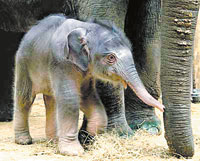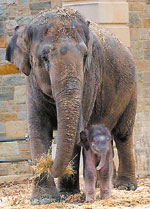|
Asian
Elephant The Elephant is essentially a vegetarian; its food consists of various species of succulent grasses, creepers, bamboo shoots, leaves, fruits, bark and sappy stems. It’s rather fastidious when grazing and will carefully clean tufts of grass/ creepers by shaking or knocking them against his body to shake off soil or dust. An adult elephant needs 90 litres of water and 150kg of food per day. The Asian Elephant is one of the most seriously endangered species of large mammals in the world. There are no more than 60,000 free-ranging Asian Elephants. In Sri Lanka, elephants generally roam in herds of 12- 20 or more. Elephants are social animals and each herd functions as an extended family with the oldest female leading the herd. Mature male bulls only join the herd during their reproductive period. In Sri Lanka, there appears to be no definite breeding season. The period of gestation is said to vary from 18-23 months. Elephants are threatened due to poaching for their ivory as well as due to the destruction and fragmentation of their habitat. However, Asian Elephants are mostly threatened by habitat loss. This is due to the fact that unlike their African counterparts, only a small percentage of Asian elephants possess tusks. In Sri Lanka, particularly in the dry zone, elephants are increasingly threatened by the loss and fragmentation of their habitat, which is mainly caused by the clearing of forests to make way for human settlements. This has led to the human-elephant conflict, which has resulted in the death of elephants as well as the destruction of property and the loss of human life. This conflict is also fuelled by the fact that many of the crops such as sugar cane, bananas and other fruits grown by these communities are favored by elephants as food. Elephants are both culturally as well as economically important to Sri Lanka. Captive Elephants are used for hauling timber and they also take a leading part in religious processions. Many local and international tourists visit National Parks to observe elephants in the wild, thus boosting the nation’s economy through tourism. The elephant is protected under the Fauna and Flora Protection Ordinance of Sri Lanka (FFPO) administered by the Department of Wildlife Conservation. In Sri Lanka Elephants can be observed in protected areas such as Yala, Wasgomuwa, Udawalawe, Minneriya and Kaudulla. |
||||
Copyright © 2001 Wijeya Newspapers
Ltd. All rights reserved. |
 Elephants
are the largest of all terrestrial animals. The average height of
a 30-year-old male is about 8ft 10ins. It is said that, usually,
twice the girth of an Elephant’s foot gives the approximate
height at the shoulder. Elephants possess a very acute sense of
smell. However, neither its eyesight not its hearing are particularly
good.
Elephants
are the largest of all terrestrial animals. The average height of
a 30-year-old male is about 8ft 10ins. It is said that, usually,
twice the girth of an Elephant’s foot gives the approximate
height at the shoulder. Elephants possess a very acute sense of
smell. However, neither its eyesight not its hearing are particularly
good. Today
between 3,160 and 4,405 elephants are estimated to be present in
Sri Lanka (Kemf & Santiapillai, 2000) of which between 2,000
and 2,870 occur largely in the protected areas. All these estimates
may turn out to be underestimates, given the difficulty in counting
elephants in the scrub forest. Therefore the carrying capacity may
be high enough to maintain a population of 4,000-5,000 elephants.
In addition, the number of elephants in captivity too has declined
from about 670 in 1955 to between 400-600 today.
Today
between 3,160 and 4,405 elephants are estimated to be present in
Sri Lanka (Kemf & Santiapillai, 2000) of which between 2,000
and 2,870 occur largely in the protected areas. All these estimates
may turn out to be underestimates, given the difficulty in counting
elephants in the scrub forest. Therefore the carrying capacity may
be high enough to maintain a population of 4,000-5,000 elephants.
In addition, the number of elephants in captivity too has declined
from about 670 in 1955 to between 400-600 today.